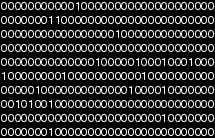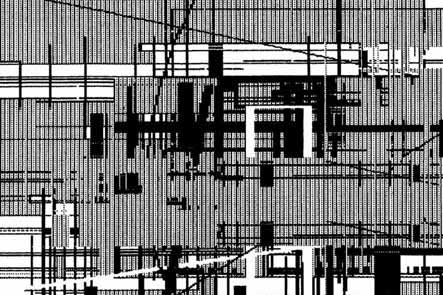
Fictitious
detail of an infinitely big number (Plottegg already 1988):
demonstrating
that there is probably no such thing as sustainability
As an architect who is very much working with the computer, using the computer for designing and planning, I want to present some points of view concerning recent developments and forthcoming preferences for our activities. As I do not like military expressions, I will not talk about strategies: I prefer to talk about algorithms, because in strategies there is a linear one way subject/object relationship, wheras algorithms provide involvement into relativity.
My center of interest is not a detached singularity (the aura of an object, the charismatic demiurge), but a dynamic interchange: architecture and urbanism are public, the planning, the method is public - and everything is on the web. Therefore public & open spaces, which are to be used simultaneously / collectively by several / many people, are the (functional) plot for a merging/morphing/scaling architecture. Since everything is changing rapidly nowadays, and since I contribute with my work in a "quick & dirty" way, I am basically opposing all strategies of sustainability.
When analysing up-to-date, advanced architecture and urbanism, we can see a paradigmatic shift taking place, which is the shift from object to process: instead of planning long-lasting buildings and rigid buildings, we are focussing on evolutionary developments and, therefore, we are changing our planning methods.
In former times, there have been other architectural rules, for instance: form, function, construction (since 2000 years!); later on, it was another rule: form follows function. But the rule above all rules still is that a building should fit the architects´ (clients´) taste. Due to this rule, architecture is reduced to anthropocentric and expressionistic settings, and due to this rule you see mainly lousy buildings, bad architecture if you take a look arround. Therefore I have been pleading for a long time for a change of rules. As fractal geometry explains, it is just the algorithm which provides the outcome (it is not the desire, the content-related thinking etc.). Just think of the CIAM programme of urbanism and compare it with what Peter Weibel has just explained about the development from the functional city to the informational city.
Nowadays we don't talk so much any more about the rules of architecture, we talk more about methods of architecture, about design methods. For instance: traditional architecture has been working (and still is) with images/pictures - facades and masterplans; in this field proportions, materials, colors, aestetics, "how buildings look like" are important; and it is in this sense that the Etoile was implanted into Paris. But recent developments tell us that we cannot continue in this way; by means of "pictures of architecture" - be it a nice looking facade or a rigid urbanistic grid - we can not solve the architectural and urbanistic problems of Mexico City, Kairo, Peking ....
The planning methods nowadays in architecture are quite different from the measures which have been applied in the 19th century, or even those which have been applied in the middle of this century. And we are lucky that they are available because the problems are quite different.
Advanced planning methods have changed radically since we have been using the computer, which started in the 80ies, on the basis of cybernetic architecture of the 70ies. When I am talking about using the computer for architectural production, I don't talk about the use of the computer to imitate what has happened before in planning or about how architects used to design by hand, by brain or by belly. And I don´t talk about the computer as drafting instrument, or as a tool for image rendering. Now we are talking about the mode in which the computer is working, with it´s artificial intelligence, based on the new system theories like fractal geometry, chaos theory, fuzzy logic and so on. That is quite different from the others, from the ancient methods of architecture which have been more or less analogue methods, and probably these new methods are better to cope with the current situation.
The central part of the computer is the CPU, the central processing unit, and this indicates that the computer is working as a processor: it is processing and controlling processes and, therefore, I think that to use the computer for processing, as the word CPU indicates, is the right use of the computer and not to make images, because rendered images belong and refer to the former analogue world of picture-making, when architecture still was a matter of making deterministic, rigid pictures, whereas nowadays in the days of processing, we are dealing with computer-processed architecture which is not any more the world of pictures. And the problems of the urbanistic agglomerations are not (and never have been) on the visual/image level, but on the level of controlled / uncontrolled processes.
In this sense, the computer as a paradigm provides us with a new toolbox, and the most important design methods are to control processes, to simulate processes and to stimulate processes. The most important programmes when using the computer nowadays are not drawing or rendering programmes. The most important programmes for production of architecture are certainly evolutionary models, growth models, game of life systems, cellular automata, swarm models, digitally generated architecture etc. There are many different approaches in that direction: think about "liquid architecture", "trans architecture", "algorithmic architecture", about John Frazer, Andi Gruber, Chris Langton, Marcos Novak, Lars Spuybroek, Andy Wünsche.....
We are dealing with quite a new toolbox of architecture - the binary/digital/algorithmic toolbox - instead of the traditional analogue toolbox. The major shift is: the anthropomorphic/expressionistic setting becomes replaced by external/algorithmic procedures, historic and value-dependent attitudes are replaced by "quick & dirty"!
With this new toolbox, we are clearly in a new world which is beyond the determinism of architecture and beyond preconceived aims in architecture. This is another paradigmatic shift, because, up to now, architecture was to design something today which will be built tomorrow and which as a building and a message should last for ever; an everlasting building was the aim. This was the old deterministic scheme of architecture and it was anthropomorphic because it has been developed out of the brain, the belly or the hand of the architects.
As you well know, the pyramids, for instance, the Colosseum in Rome, and similar buildings, are famous because they survived for a long time. Evidently there is an equation: an architect who wants to become a famous architect must build a famous building, and a famous building had the obligation to be a long-lasting building. And you can ask any tourist; he will approve of this equation. We all like old whiskies, Rembrandt drawings, traditional habits, therefore, we all like old buildings and we preserve or even reconstruct old buildings. In other words, the quality of a building is a function of duration. I think these elements come out of a conservative world which has nothing to do with the contemporary evolutionary point of view.
To determine has been the basic idea of architectural planning up to now, although determinism has been overcome in philosphy, art and science since a long time. If I should make a manifest for the architecture of the 21st century I would outline that architecture will become non-deterministic, by changing from designing objects to designing procedures.
In the up-to-date toolbox, as I explained
before, the toolbox with which we are starting into a new millennium, we
have digital evolutionary algorithmic elements, and so on. But I can't
find in this toolbox any programme which is called sustainability. And,
therefore, I suppose that sustainability is a traditional tool which is
designed to prolong elements which should rather be deleted.

Fictitious
detail of an infinitely big number (Plottegg already 1988):
demonstrating
that there is probably no such thing as sustainability
I think sustainability is a conservative tool which does not create new ideas. It is a tool which wants to keep things running as they are. For instance, everybody is afraid that the globe becomes overheated. Therefore sustainability is a very good topic for a symposium and an ideal instrument to raise money from Brussels.
Architecture and urbanism should be less afraid and should be less concerned with sustaining bad systems, bad existing economic systems, and bad political systems. Architecture and urbanism had better focus on evolutionary models and in other directions where new ideas can be developed. Instead of images and objects, we should design processes and entertainment. This should prove to be rather simple, because today we do know how networking, evolutionary and autocatalytic models are structured instead of rigid centralistic models, and we do know how to change from content-related design with aims and desires to the design of systems.
The method of forward-planning never looks back, it accelerates architecture. As architecture is a slow medium, which did not accept the major scientific changes in the 20th century (from expressionism to algorithms, from determinism to relativism, from constructivism to deconstructivism ....... see exhibition "Beyond Art" curated by P.Weibel, Antwerpen 1998) it is even more urgent that new browsing systems become part of our planning methods. To accelerate architecture, design must be dynamised, the design process simulates/stimulates real-life procedures.
The forward planning method is not (as usual) linear from the first sketch to the "finished project", from one scale to the next bigger scale - where the finished project differs from the beginning only in terms of details. The forward planning process is modifying permanently - not in the sense of correcting errors or of improvement of the world, but on behalf of pemanent changes of surrounding variables, growth or changing of functions.
As seen from the point of view of the theory of architecture, the rigid images (object, proportion, aestetics) of traditional architecture become abandoned and shifted towards the control, steering of (urban, architectonic, building) processes. Building science is not understood as object-related (function, structure, typology) any more, but as a mode of procedure, as (planning) method. The function of "the function in architecture" is not the object / form any more, but rather the process. An object as building is not the aim, may be the result. Buildings are changing (ref. Steward Brand: "how buildings learn") and the history of architecture confirms this: after the traditional building-body-architecture (volume, mass) and subsequently the structural architecture, we are nowadays designing information-architecture. Built architecture becomes the flesh for the wireframe-model of reality. The theory of mapping / merging / morphing different electronic, physical and social spaces together as the new "site" of architecture is the basis for the concept of virtual&real-life space. Thus - after the rigid, deterministic design of definite conditions, and after the concepts for the design of developments - the transition to an architecture of process-design is formulated and thus the transition towards architecture-algorithms, towards autocatalytic and genetic architecture takes place.
In a world of self-emerging systems,
there are no such things as man-made strategy or sustainability, which
are abstruse and oldfashioned items.

automatic generative design:
"universal template" (Plottegg already 1987)